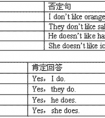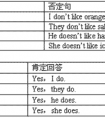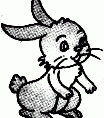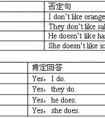按要求改写句子。1. Mr. Wood teaches us math. (改为一般疑问句) ____________ Mr. Wood ____________us math? 2. I have a yellow dress. (改为否定句) I ________-六年级英语
手帕树叶半空飘。handkerchief,leaf,half↓
(一) 规则变化
名词单数变复数,直接加 -s 占多数;
s, x, z, ch, sh 来结尾,直接加上 -es;
词尾是 f 或 fe,加 -s 之前先变 ve;
辅母 + y 在词尾,把 y 变 i 再加 -es;
词尾字母若是 o,常用三个已足够,要加 -es 请记好,hero, tomato, potato。
(二) 不规则变化
男人女人 a 变 e,鹅足牙 oo 变 ee;
老鼠虱婆也好记,ous 变 ic;
孩子加上 ren,鱼鹿绵羊不用变。
【解说】
1. 英语名词有单数和复数的区别,单数表示“一”,复数表示“多于一。”
名词由单数变复数,多数是规则的变,直接加 -s,例如:book → books, girl → girls。但以 -s, -z, -x, -ch, -sh 结尾的名词,变成复数时加 -es,
例如:bus → buses, buzz → buzzes, box → boxes, watch → watches, brush → brushes
2. -f(e) 结尾的名词单数变复数歌诀:
① 树叶半数自已黄,妻子拿刀去割粮,架后窜出一只狼,就像强盗逃命忙。
② 妻子持刀去宰狼,小偷吓得发了慌,躲在架后保己命,半片树叶遮目光。
例如:leaf (树叶,叶子),half (一半),self (自已),wife (妻子),knife (刀子),shelf (架子),wolf (狼), thief (窃贼,强盗) 和 life (生命),
这些名词变成复数时,都要改 -f (e) 为 v,再加 -es。
3. -f 结尾的名词直接加 -s 变复数歌诀:海湾边、屋顶上,首领奴仆两相望;谁说他们无信仰,证据写在手帕上。
例如:gulf, roof, chief, serf, belief, proof, handkerchief,这些名词变复数直接加 -s。
注:scarf(围巾;披风) 可以先改 f 为 ve 再加-s,也可直接加 -s。
4. 辅音字母 + y 结尾的名词,把 y 变 i 加 -es。
例如:baby → babies, country → countries, family → families;而 -y 前是元音时,-y 不变,直接加 -s。例如:day → days, boy → boys
5. 以 -o 结尾的名词变复数时,多数直接加 -s。
例如:radio → radios, piano → pianos, kangaroo → kangaroos;有的须加 -es,中学课本中有几个这样的单词,可以通过一句口诀来记忆:黑人英雄爱吃西红柿和土豆。
即:Negro → Negroes, hero → heroes, tomato → tomatoes, potato → potatoes;有的以 o 结尾的名词既可加 -s 也可加 -es。
例如:volcano (火山) → volcanos / volcanoes 等。
6. 名词复数的不规则变化需要特别记忆。
例如:man → men, woman → women, goose → geese, foot → feet, tooth → teeth, mouse → mice, louse (虱子) → lice, child → children, fish → fish, deer (鹿) → deer, sheep → sheep 等。
7. 初中课本中表示“某国人”的名词复数形式变化可通过歌诀记忆:中日不变英法变,其余 -s 加后面。
例如:Chinese → Chinese, Japanese → Japanese;
Englishman → Englishmen, Englishwoman → Englishwomen, Frenchman → Frenchmen, Frenchwoman → Frenchwomen;
American → Americans, Rusian → Rusians, Arab → Arabs, German → Germans 等。
8. 不可数名词一般只有单数形式,没有复数形式。有些不可数名词可借助单位词表示一定的数量。
例如:a cup of tea 一杯茶
, two piece of paper 两张纸, an item of news 一则新闻
考点名称:否定句
- 否定句:
表示否定的句子。必须有否定词。
否定句的构成形式:
a. 谓语为be动词时,“be+not "一名学生。
b. 谓语为实义动词而且没有情态动词和助动词时,“do/ does/ did+not"构成否定。
例:I do not like dancing. 我不喜欢跳舞。
He does not want to go to school. 他不想去上学。
c. 谓语为“情态动词+实义动词”时,“情态动词+not”构成否定。
例:You must not smoke. 你千万不要吸烟。
I can not catch it. 我抓不住它。 - 否定句在英语语法中可以分为九类:
(1)一般否定句
I don't know this. No news is good news.
There is no person(smoking)/not a person/not any person(smoking)in the house.
(2)特指否定
He went to his office, not to see him.
I am sorry for not coming on time.
I don't think/believe/suppose/feel/imagine you are right.
(3)部分否定
All the answers are not right
All is not gold that glitters
I don't know all of them.
I can't see everybody/everything.
Both of them are not right.
(4)全体否定
None of my friends smoke.
I can see nothing/nobody.
Neither of them is right.
Nothing can be so simple as this.
(5)延续否定
You didn't see him, neither/nor did I.
You don't know, I don't know either.
He doesn't know English, let alone/to say nothing of/not to speak of(更不用说)French.
(6)半否定句
We seldom/hardly/scarcely/barely hear such fine singing.
I know little English. I saw few people.
(7)双重否定
You can't make something out of nothing.
What's done cannot be undone.
There is no sweet without sweat.
No gain without pains.
I can't help /keep/ laughing whenever I hear it.
No man is so old but(that)he can learn.
(8)排除否定
Everyone is ready except you.
He did nothing but play.
But for your help, I couldn't do it.
(9)加强否定
I won't do it at all.
I can't see it any more.
He is no longer a boy. 否定转移的形式与用法:
一、动词的否定转移
1.形式上否定主句的谓语,实际上是否定从句的谓语
当动词“think”、“believe”、“suppose”、“imagine”、“expect”、“feel”的主语是第一人称,谓语动词为没有任何副词修饰的一般现在时,它们的否定式实际上是对宾语从句的否定。
表示说话者提出一种委婉的看法或主张。如:
I think that he will help us.——I don’t think that he will help us. 我认为它不会帮助我们。
I believe that he is right.——I don’t believe that he is right. 我认为他不对。
I suppose that he likes it.——I don’t suppose that he likes it. 我想他不喜欢它。
2. 形式上否定谓语动词,实际上否定复合宾语
当动词“think”、“believe”、“suppose”、“imagine”、“expect”、“feel”、“find”的主语是第一人称,谓语动词为没有任何副词修饰的一般现在时,它们前面的否定式实际上是对复合宾语的否定。表示说话者所提出的一种委婉的看法或主张。如:
I think math difficult. — I don’t think math difficult. 我认为数学不难。
I find the story interesting. — I don’t find the story interesting. 我认为这个故事没有趣。
I expect so. —I don’t expect so. 我认为不会。
二、动词“think”、“believe”、“suppose”、“imagine”、“expect”、“feel”在下列情况下,否定不转移:
1.这些动词跟其他另一个动词一起做并列谓语时,否定不转移。如:
I believe and hope he won’t do that. 我相信并且也希望他将不会那样做。
I feel and admit that we are not foolish. 我觉得并且也承认我们并不愚蠢。
2.用于疑问句时,否定不转移。如:
Do you think it is not going to rain? 你认为天不会下雨吗?
Don’t you believe that he has done a good thing? 难道你不相信他做了一件好事?
3.用作插入语时,否定不转移。如:
Li Lei, I think, won’t be angry with you. 我想李蕾不会生你的气。
Tom, I suppose, won’t be against it. 我猜想汤姆不会反对。
Mike, I believe, hasn’t seen the film. 我认为迈克没有看这场电影。
4.动词前有其他副词修饰时,否定不转移。如:
I really don’t think it’s necessary for us to go there now. 我的确不认为我们有必要去那儿。
I feel strongly that he shouldn’t do such a thing. 我强烈地认为他不应该做那样的事。
5.动词为非一般现在时或主语不是第一人称时,否定不转移。
I thought that he wouldn’t come back soon. 我原以为他不会回来得这么快。
She didn’t believe that he became a good boy. 她不相信它变成了一个好孩子。
He thinks that he isn’t fit for the job. 他认为他不适合这件工作。
He doesn’t believe that what we told him is true. 他不相信我们告诉他的事是真的。
6.当宾语从句中含的否定为“not……at all”、“not a little”、“not a few”、“not enough”、“can’t help”等固定搭配时,否定不转移。如:
- 最新内容
- 相关内容
- 网友推荐
- 图文推荐
| [家长教育] 孩子为什么会和父母感情疏离? (2019-07-14) |
| [教师分享] 给远方姐姐的一封信 (2018-11-07) |
| [教师分享] 伸缩门 (2018-11-07) |
| [教师分享] 回家乡 (2018-11-07) |
| [教师分享] 是风味也是人间 (2018-11-07) |
| [教师分享] 一句格言的启示 (2018-11-07) |
| [教师分享] 无规矩不成方圆 (2018-11-07) |
| [教师分享] 第十届全国教育名家论坛有感(二) (2018-11-07) |
| [教师分享] 贪玩的小狗 (2018-11-07) |
| [教师分享] 未命名文章 (2018-11-07) |





![____ it got four wheels?[ ]A. Have B. There C. Has-五年级英语](http://www.00-edu.com/d/file/ks/4/1/65/2019-08-31/small2ca0aeba76320ba6f81e40fe83a0e8111567199443.png)
